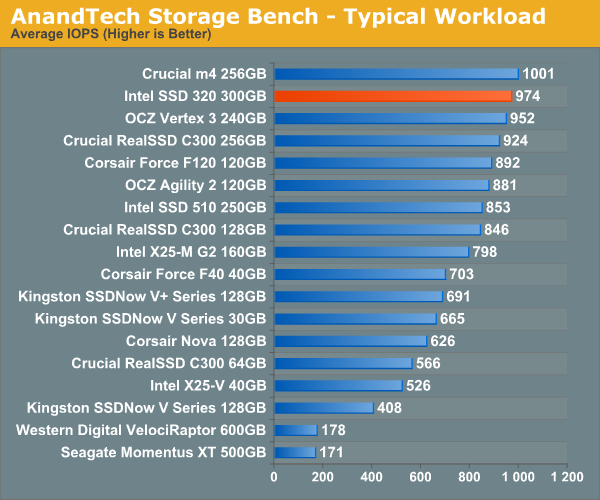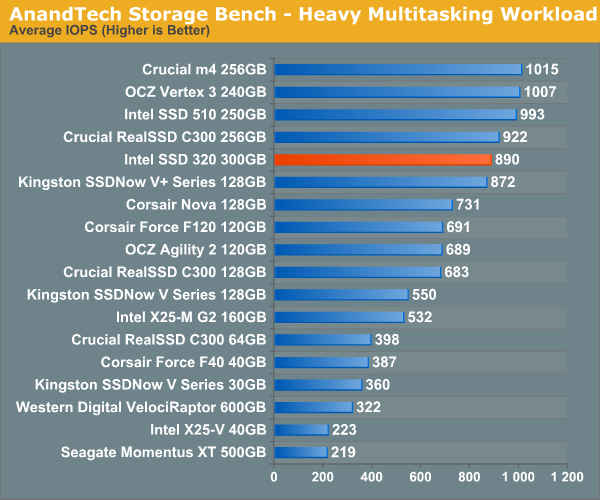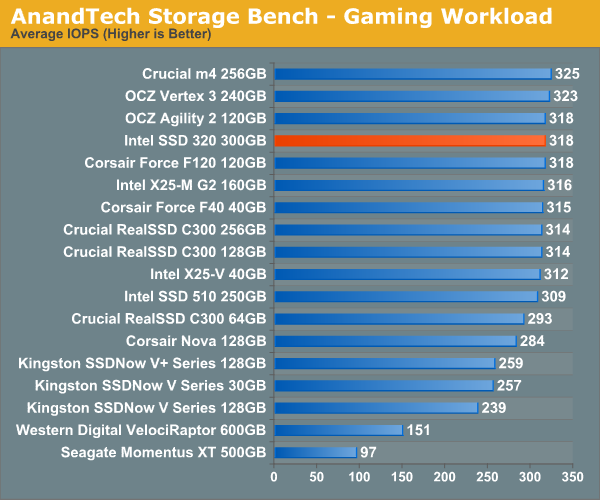The Intel SSD 320 Review: 25nm G3 is Finally Here
by Anand Lal Shimpi on March 28, 2011 11:08 AM EST- Posted in
- IT Computing
- Storage
- SSDs
- Intel
- Intel SSD 320
AnandTech Storage Bench 2010
To keep things consistent we've also included our older Storage Bench. Note that the old storage test system doesn't have a SATA 6Gbps controller, so we only have one result for the 6Gbps drives.
The first in our benchmark suite is a light/typical usage case. The Windows 7 system is loaded with Firefox, Office 2007 and Adobe Reader among other applications. With Firefox we browse web pages like Facebook, AnandTech, Digg and other sites. Outlook is also running and we use it to check emails, create and send a message with a PDF attachment. Adobe Reader is used to view some PDFs. Excel 2007 is used to create a spreadsheet, graphs and save the document. The same goes for Word 2007. We open and step through a presentation in PowerPoint 2007 received as an email attachment before saving it to the desktop. Finally we watch a bit of a Firefly episode in Windows Media Player 11.
There’s some level of multitasking going on here but it’s not unreasonable by any means. Generally the application tasks proceed linearly, with the exception of things like web browsing which may happen in between one of the other tasks.
The recording is played back on all of our drives here today. Remember that we’re isolating disk performance, all we’re doing is playing back every single disk access that happened in that ~5 minute period of usage. The light workload is composed of 37,501 reads and 20,268 writes. Over 30% of the IOs are 4KB, 11% are 16KB, 22% are 32KB and approximately 13% are 64KB in size. Less than 30% of the operations are absolutely sequential in nature. Average queue depth is 6.09 IOs.
The performance results are reported in average I/O Operations per Second (IOPS):

If we strip 6Gbps out of the equation completely, the SSD 320 does very well in our old light workload. You're looking at performance that's at the top of the pack from the mainstream offering.
If there’s a light usage case there’s bound to be a heavy one. In this test we have Microsoft Security Essentials running in the background with real time virus scanning enabled. We also perform a quick scan in the middle of the test. Firefox, Outlook, Excel, Word and Powerpoint are all used the same as they were in the light test. We add Photoshop CS4 to the mix, opening a bunch of 12MP images, editing them, then saving them as highly compressed JPGs for web publishing. Windows 7’s picture viewer is used to view a bunch of pictures on the hard drive. We use 7-zip to create and extract .7z archives. Downloading is also prominently featured in our heavy test; we download large files from the Internet during portions of the benchmark, as well as use uTorrent to grab a couple of torrents. Some of the applications in use are installed during the benchmark, Windows updates are also installed. Towards the end of the test we launch World of Warcraft, play for a few minutes, then delete the folder. This test also takes into account all of the disk accesses that happen while the OS is booting.
The benchmark is 22 minutes long and it consists of 128,895 read operations and 72,411 write operations. Roughly 44% of all IOs were sequential. Approximately 30% of all accesses were 4KB in size, 12% were 16KB in size, 14% were 32KB and 20% were 64KB. Average queue depth was 3.59.

Crank up the workload and the 320 falls a bit behind the rest of the competitors. Last year's heavy multitasking workload is nothing compared to what we introduced earlier this year, so it's still pretty light by comparison but it's clear for normal usage the 320's 3Gbps performance is quite good.
The gaming workload is made up of 75,206 read operations and only 4,592 write operations. Only 20% of the accesses are 4KB in size, nearly 40% are 64KB and 20% are 32KB. A whopping 69% of the IOs are sequential, meaning this is predominantly a sequential read benchmark. The average queue depth is 7.76 IOs.











194 Comments
View All Comments
Morten.DK - Monday, April 11, 2011 - link
One thing that bothers me a bit: It seems that the smaller drives has a lower spare area percentage than the 300GB drive.120GB: Physical 120GB, user capacity 111GB, spare ares 9GB which is 7.5%
160GB: Physical 160GB, user capacity 149GB, spare area 11GB which is 6.9%
300GB: Physical 320GB, user capacity 279GB, spare area 41GB which is 12.8%
600GB: Phycical 640GB, user capacity 558GB, spare area 82GB which is 12.8%
Does this mean that the smaller drives does not have the same RAID4-like redundancy as the 300GB drive? Or am I wrong about the physival sizes of the smaller drives?
noblemo - Thursday, April 14, 2011 - link
There are two factors in your calculation: 1) spare area, and 2) GB to GiB conversion. I believe the spare area is as follows:120 GB: 128-120 = 8 GB spare area = 6.25%
300 GB: 320-300 = 20 GB spare area = 6.25%
600 GB: 640-600 = 40 GB spare area = 6.25%
I am not sure about the 160GB model; if it uses six 32GB chips, then the spare area is 16.7%. If it uses five 32GB chips, then there is no spare area.
To convert GB to GiB, divide by 1.024^3:
120 GB = 111.8 GiB
160 GB = 149 GiB
300 GB = 279 GiB
600 GB = 559 GiB
So the 120 GB drive has 128 GB total area and 8 GB spare area (6.25%). This is equivalent to 111.8 GiB with 119.2 GiB total area and 7.45 GiB spare area (6.25%).
noblemo - Friday, April 15, 2011 - link
My previous post was incorrect. The 300GB and 600GB drives have 12.8% spare area, while the smaller drives have 6.8%.mattr00 - Sunday, April 17, 2011 - link
Hey Anand,Thanks as always for a great review. Is there any ETA on benchmarking the 120GB version of this? All of the reviews I see online are 300GB and I'm itching to know whether the 120GB performance is significantly lower than the 300GB performance. I'm considering buying the 120GB, but it has lower IOPS write performance than 300GB according to Intel specs, which I fear will mean low random write performance in the real world.
Thanks!
Surlias - Saturday, April 23, 2011 - link
I've been unable to find a review comparing the 40gb G2 and the 40gb G3 models. Anyone have any experience with both of these models, or perhaps can point me to a review of the 40gb G3 somewhere? I'm sitting on an unopened G2 trying to decide if I want to go to the trouble of exchanging it for a G3. I'd save a few bucks in the process, but if the performance isn't any better then I'd just as soon stick with the G2 and its proven reliability.ross999 - Tuesday, April 26, 2011 - link
I know the documentation says that an ATA password is required to use the device level encryption, and that Mac's OS EFI password isn't quite the same. However, I've spoke with both Intel and Apple, and neither can provide any details about compatibility of these passwords for purposes of encryption. Really, Intel, you don't know if it will work with MacOS? Bizarre.Can anyone shed first-hand knowledge on this?
MB17 - Saturday, May 7, 2011 - link
Cost difference is little to consider for me, so if someone can help:On 3 GBPS systems, I understood that the Intel 320 is a little bit better in real life performance than the 510. Is this correct?
Also, 510 is a little more future proof (if I ever change to a 6GBPS system) and 320 gives me more storage space, right?
These seems to be my main points of consideration, right, or am I overlooking something?
Any definitive reason to buy one over the other?
Thanks so much for any help.
PS: How much free space do I get from the 510 (unlike the 320 I could not find this info)
garuda1 - Monday, May 23, 2011 - link
Does anyone know why Intel's Toolbox won't TRIM an SSD mounted in an external enclosure. It will migrate, but won't TRIM. Intel responded in an email by only saying:“We don’t validate or authorize use of SSD Optimizer through eSATA enclosures. If a customer wants to use an eSATA enclosure, they must understand they are using a configuration that is not validated by Intel and they are on their own.
-If customer wants to use Optimizer on an Intel SSD, suggest they connect it directly to the host system."
But is there a specific reason for this? And will Intel eventually modify the Toolbox to accommodate external SSDs in the near future. Once the host system case is full, the only alternative is external enclosures. Is there some design or F/W limitation that precludes externals?
P.S. - Intel's FAQ section on their website specifically mentions that SSDs are compatible with external eSATA enclosures (unless they recently changed it). This is what led me to believe that my recent purchase of two S320 600GB SSDs would function and optimize in external eSATA enclosure which I also purchased. Thanks for any feedback.
garuda1 - Monday, May 23, 2011 - link
Note question and answer# 4 in the following link at Intel FAQs:http://download.intel.com/support/ssdc/hpssd/sb/in...
hoofy - Monday, August 22, 2011 - link
I am really concerned how the 40GB SSD 320 will perform as i am planning to buy it as an OS drive. My other options are vertex 2 40GB and X-25-V 40GB. Please recommend me guys the best drive among these three.